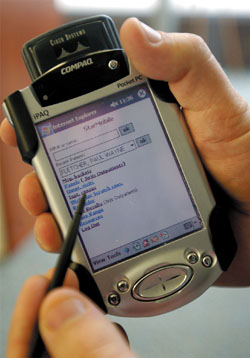
Dr. Jim Jirgis, who enjoys the flexibility of VUMC’s wireless plan, uses his PDA to access patient information while not in the office. (photo by Dana Johnson)
Wireless access allows doctors greater mobility

Hand-held PDAs are being used to access patient information. (photo by Dan Johnson)
Dr. Jim Jirjis was watching his son play ball on a Saturday afternoon this summer when his electronic pager went off. As one of about 25 attending physicians who practice in the adult primary care center, it was Jirjis’ turn that weekend to respond to off-hour patient calls to the center. Jirjis is assistant professor of medicine and medical director of the adult primary care center.
The call was from a patient of a colleague, a patient who would thus be completely unknown to Jirjis. He punched in the patient’s phone number on his cell phone. The patient was experiencing apparent rectal bleeding.
Without moving from his perch at the ballpark, Jirjis began reviewing the patient’s entire medical record. He had brought his hand-held computer along to the park. While talking with the patient, Jirjis used the computer to access the VUMC intranet via T-Mobile, a commercial wireless telecommunications service.
Among the patient’s current medications Jirjis found a high blood pressure medication known to cause constipation. He scanned a gastroenterology note describing a recent colonoscopy that had turned up nothing more than internal hemorrhoids. This combination of facts from the medical record, together with information from the patient, provided immediate grounds to lessen the patient’s fears and concerns and focus on hemorrhoid treatment.
“The patient asked me how I knew so much about his medical history, was I in the office,” Jirjis said. “I told him I was at the ballpark watching my kid play.” The patient was impressed.
Targeted use of wireless technology to provide short-range network access has long been employed by various groups in Vanderbilt University Hospital. Now, with help from the informatics center, Jirjis and a small but growing number of other doctors are expanding use of this technology, using palm-top computers to access patient records and perform work over the VUMC intranet. They’re working from around campus via short-range wireless connections; they’re working from living room couches and backyard patios via short-range connections installed at home; and they’re able to work from the ballpark or anywhere else on the planet reached by digital cell phone signals. Browser-based encryption protects VUMC patient privacy.
The particular application that Jirjis found so useful that day at the ballpark was StarMobile, an electronic medical record system that links with clinic scheduling and hospital admission systems to support management of individual patients and patient groups. StarMobile includes a messaging function to streamline communication among doctors and other members of the outpatient care team. StarMobile is the hand-held version of StarPanel, delivering all of the latter’s information and functionality, but formatted to fit the smaller screen of the PDA, or personal digital assistant —also called a palm-top or hand-held computer. The StarMobile Web address is the same as that of StarPanel; the system identifies that the user is on a PDA and automatically uses StarMobile for the session. In addition to using StarMobile from his PDA, Jirjis uses the VUMC e-mail system, where he also keeps his calendar.
Under an initiative called E3, Vanderbilt Medical Group and the informatics center are working to remove paper-based processes from outpatient practice areas by February 2003. The complete patient record will be electronic — orders for tests and drugs, clinical notes, test results, letters from referring physicians, phone messages, faxes. Early this year Jirjis’ practice group became the first VMG clinic to function entirely without paper-based clinical processes. Many of the center’s documents are generated electronically, and those that aren’t, such as outside test results and referral letters, are scanned and indexed to the electronic record. “I can have the entire medical record in my hand at any given time, anywhere,” Jirjis said.
Impact
Jirjis says wireless communication will support quality of care, physician productivity and patient satisfaction.
“Wouldn’t you like to know that the doctor on the phone covering for your doctor has your chart in front of her, wherever she is?,” Jirjis said. “I know of patients who have had drugs with potential interactions prescribed over the weekend because the doctor did not have the patient’s chart available when she took the call. Wireless access is about safety, quality of care and convenience. This can help set us apart from other providers in the community.”
When Jirjis spent a recent afternoon in one meeting after another, he was able to use spare moments between meetings to check his StarMobile in-box, referencing medical records and sending replies to his team. “I didn’t come out of that afternoon behind on my clinical work, I wasn’t punished for participating.” He has worked with StarMobile while waiting for his daughter’s karate class to let out, saving himself from having to work at home or come to the office early the next day. He uses StarMobile at home via a short-range wireless connection to his cable Internet service. “I would much rather answer e-mails or finish StarPanel stuff on the couch with my wife while she is reading a book or watching TV than to be in my home office sitting behind the computer.”
It’s not the ability to work all the time that Jirjis values; rather, it’s the ability to work where and when he chooses. “I will never be without wireless access,” he said. “My quality of life took a huge leap of improvement with the advent of wireless tools for StarPanel. I am not tied to the physical location of my office; the old ‘ball and chain’ of only being able to do my work in one location is gone. It’s very emancipating.”
Options for users
No training or special software is needed to use Vanderbilt applications in a wireless setting. The division of general internal medicine and the adult primary care center are working to help doctors acquire PDAs. There’s no telling when or if other groups will follow suit. Meanwhile, the price is rapidly coming down and the speed of wireless computer connections is improving.
Via antennas installed in ceilings, users have fast short-range wireless connections to the Vanderbilt computer network throughout VUH and in a growing number of other campus locations, including floors 1-3 of Eskind Biomedical Library and floors 3, 5, 6 and 7 of Medical Center East. A proposal is under consideration to blanket TVC with wireless connectivity within the current fiscal year. The new Children’s Hospital and the new Bill Wilkerson Center, both now under construction, will open with blanket wireless coverage.
Users can install fast short-range connections to their home phone or cable Internet service, and when they’re mobile they can connect to the Vanderbilt intranet over commercial wireless telecommunication networks. Though there’s some tradeoff of speed for mobility, Jirjis finds that wireless speeds are quite good, particularly when using campus wireless connections.
Today’s PDAs give users the entire Internet. There are a growing number of sites formatted to fit the PDA screen; Eskind Digital Library navigation comes formatted for the palm-top and some leading medical reference sites do too. Users not averse to scrolling can choose to view Web pages as formatted for regular desktop browsers. To fit non-PDA Web sites to the small screen, users can select “text only” versions of Web sites. For those users who would want to write messages or enter information, PDAs offer increasingly fluent handwriting recognition, and if you don’t care to write in block letters with a stylus, you can attach a portable keyboard.
Laptops can of course offer the same wireless capabilities as PDAs. Jirjis points out that, when traveling, Vanderbilt doctors, researchers and administrators may find value in using the Internet/VUMC intranet in a wireless setting, without having to purchase access at hotels and airports.
Jirjis said cost depends in part on where you want to use the device. A PDA for use with the high-speed short-range network here on campus will run around $400. Installing short-range wireless connectivity at home is easy, with the cost running between $100 and $150 (if you have a desktop computer at home, the transmitter simply plugs into the USB port). For roughly $850 you can buy a PDA with accessories that will connect at Vanderbilt, at home and over cell phone networks.
Away from campus and away from home, users can use their cell phone to relay the Internet to their PDA, or can manually switch out cards to adapt their PDA to pick up a cell phone network directly. T-mobile offers unlimited wireless megabytes to Vanderbilt employees for $32.99 per month.
From the informatics center, the StarPanel/E3 developers include Dario Giuse, associate professor of Biomedical Informatics, Qinghua Kou, systems software specialist, and Dr. Bill Gregg, clinical fellow. Development is based on close collaboration with the clinics, particularly with Jirjis and the adult primary care center, where StarPanel was piloted and where further electronic medical records system enhancements are now under development. StarMobile was formatted for the PDA by Kou in collaboration with Jirjis.
Vanderbilt Medical Group members seeking more information on wireless hardware options can contact Dr. Jim Jirjis at jim.jirjis@-vanderbilt.edu.
There’s also a Web site now under development to assist Vanderbilt’s PDA users: www.mc.vanderbilt.edu/-pdasig/. Within a month the site will become a reference for PDA resources and hardware options.













